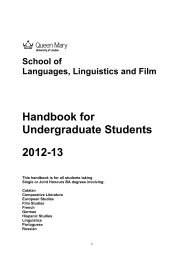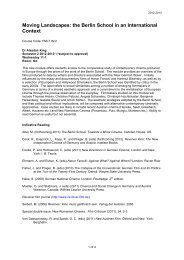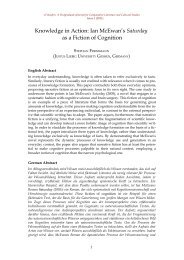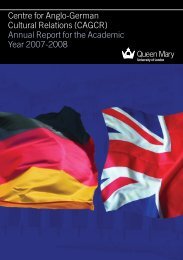Finnegans Wake - Queen Mary, University of London
Finnegans Wake - Queen Mary, University of London
Finnegans Wake - Queen Mary, University of London
You also want an ePaper? Increase the reach of your titles
YUMPU automatically turns print PDFs into web optimized ePapers that Google loves.
eTransfers. A Postgraduate eJournal for Comparative Literature and Cultural Studies<br />
Issue 1 (2011)<br />
disclosures that share many <strong>of</strong> the structural features <strong>of</strong> Dasein. To begin our close<br />
reading <strong>of</strong> <strong>Finnegans</strong> <strong>Wake</strong>, I will present two long quotations exploring the text’s<br />
notion <strong>of</strong> fallenness which will then be analysed in detail. Upon the “fall <strong>of</strong> a once<br />
wallstrait oldparr,” we learn <strong>of</strong> Finn that,<br />
[t]he humptyhillhead <strong>of</strong> humself promptly sends an unquiring one well to the west<br />
in quest <strong>of</strong> his tumptytumtoes: and their upturnpikepointandplace is at the knock in<br />
the park where oranges have been laid to rust upon the green since devlinsfirst<br />
loved livvy […]. Well, Him being so on the flounder <strong>of</strong> his bulk like an overgrown<br />
babeling […] from the foot <strong>of</strong> the bill to ireglint’s eye he calmy extensolies. (FW 3–6)<br />
“Humptyhillhead” suggests the head <strong>of</strong> the fallen HCE (in his primordial incarnation<br />
as Big Master Finnegan) lies at the hill <strong>of</strong> Howth Castle (HCE is ‘Howth Castle<br />
Environs’). West <strong>of</strong> Howth hill lies the village <strong>of</strong> Chapelizod, with its turnpike, and<br />
Phoenix Park, where it is suggested Finn’s feet rest “upturnpikepointandplace”. We<br />
are told that, lying prone he “calmly extensolies”, suggesting “extended, so lies” with<br />
perhaps also an echo <strong>of</strong> ‘existential’. We learn similarly <strong>of</strong> his son, Shaun, that, as the<br />
four judges approach him to enquire into the nature <strong>of</strong> his Being,<br />
[a]feared themselves were to wonder at the class <strong>of</strong> a crossroads puzzler he would<br />
likely be, length by bredth nonplussing his thickness, ells upon ells <strong>of</strong> him, making<br />
so many square yards <strong>of</strong> him, one half <strong>of</strong> him in Conn’s half but the whole <strong>of</strong> him<br />
nevertheless in Owenmore’s five quarters. There would he lay till they would him<br />
descry, spancelled down upon a blossomy bed, at one foule stretch, amongst the<br />
daffydowndillies, the flowers <strong>of</strong> narcosis fourfettering his footlights, a halohedge <strong>of</strong><br />
wild spuds hovering over him, epicures waltzing with gardenfillers, puritan shoots<br />
advancing to Aran chiefs. (FW 475)<br />
Shaun is described as lying across Ireland’s ancient divide between “Conn’s half”<br />
and “Owen’s half,” being covered by various kinds <strong>of</strong> potatoes (Flounders, Epicures,<br />
Garden Fillers, Aran Chiefs). Much like Dasein, HCE does not, in its regular,<br />
everyday comportment, encounter itself as a detached, Cartesian subject. Both Finn<br />
and Shaun are woven into the landscape. Like Dasein, HCE is an existential clearing<br />
in which man and world show up. If Dasein is said to be ‘Being-in-the-world’, HCE<br />
might be termed, in accordance with his publican pr<strong>of</strong>ession, as ‘Being-INN-the-<br />
world’. The world <strong>of</strong> the <strong>Wake</strong> is not a simple ‘wherein’ <strong>of</strong> a narrative but a surreal<br />
manifestation bound-up with that narrative.<br />
7







